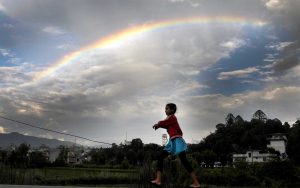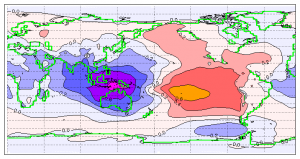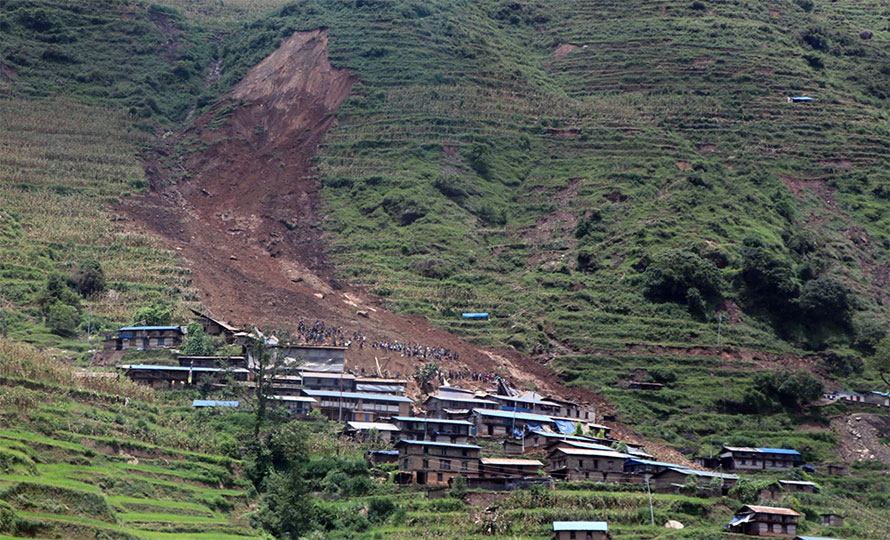
As the monsoon season looms, this year’s weather forecast says most regions will likely have below-average rainfall. On May 4, the Department of Hydrology and Meteorology released its weather outlook for the monsoon season (June-September 2023). According to the report, most regions, with the exception of a few areas in the eastern hills and Terai, will have a 35-55 per cent likelihood of below-average rainfall. Additionally, the outlook predicts higher maximum and minimum temperatures during the season, which strongly suggests a hot and dry monsoon.
Hydrologist Sudarsan Humagain says the monsoon brings 1472mm of rain to the country on average while the temperature ranges from 29.4 to 21 degrees Celsius. The monsoon season accounts for almost 80 per cent of the total rainfall for the year, according to the New York Times. During the four-month monsoon season, a certain location receives enough rainwater to fill 1.5 water bottles on average. However, the weather forecast indicates that some regions–such as Gandaki, Karnali and Sudurpaschim provinces and the flatland of Koshi–may have warmer temperatures but less rainfall than usual. “These areas may face drought and above normal heat during the monsoon,” Humagain says.
So does a dry monsoon mean a season free of natural hazards? Experts say it is not.
Increasing risks of extreme weather events in monsoon
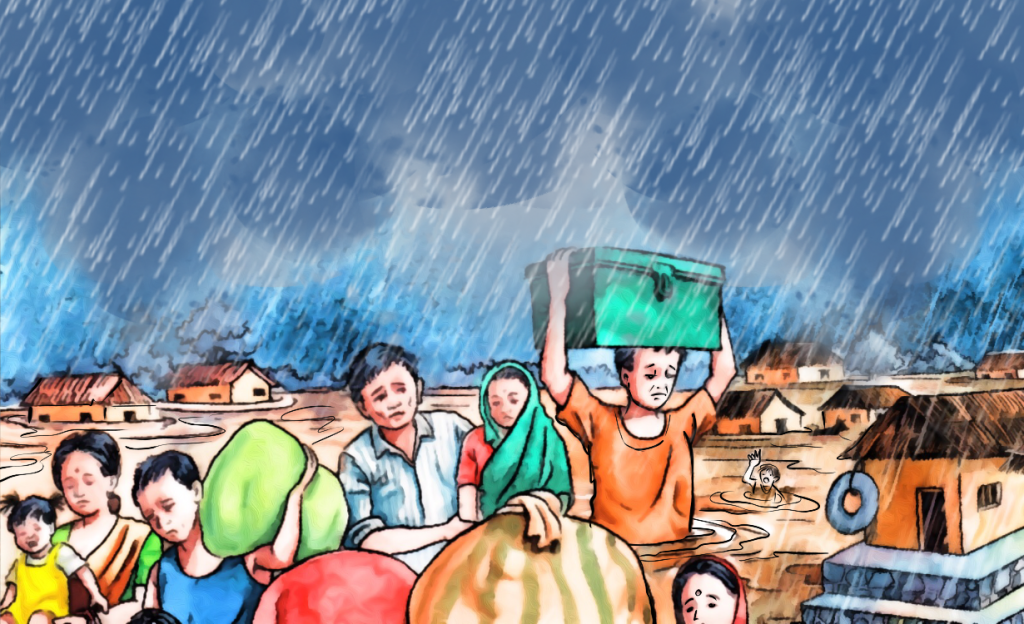
While it may be tempting to assume that a forecasted dry monsoon season means lower hazards, the reality is quite different. The Department of Hydrology and Meteorology warns of a high risk of flash floods, landslides, and other monsoon-related hazards that could cause disasters. This is due to the inaccuracy of seasonal forecasts in predicting the likelihood and distribution of rainfall.
Binod Pokharel, an associate professor at Tribhuvan University’s Central Department of Hydrology and Meteorology, says weather events are becoming more intense, extreme, and unpredictable. Unpredictable extreme weather events that have caused both economic and human losses in recent years have provided compelling evidence of this trend.
“Intense rainfall within a short period in a certain area can lead to hazards such as flash floods, mudslides in hilly areas, and landslides,” he says.
Although technological advancements have significantly enhanced the understanding of weather patterns, long-term forecasts cannot always precisely predict the timing or location of heavy rainfall. To avoid any potential dangers, the authorities advise people to stay alert and take the appropriate precautions throughout the monsoon season even though it is a dry monsoon.
Community-based early warning systems can be an efficient alarm system for communities that are at risk. The Nepal government has collaborated with both national and international organisations, including ICIMOD, to improve early warning systems.
Seasonal forecasts are not enough to prepare for disasters

The monsoon season last year served as a warning that tragedy might strike without warning, even when forecasts are available. Even though above-average rainfall was predicted, areas like Narainapur in Banke experienced almost no rain during the middle of the monsoon, resulting in drought conditions. Anil Pokharel, the head of the National Disaster Risk Reduction and Management Authority (NDRRMA), warns that a flash drought during the middle of the monsoon this year may add to the pressure already there regardless of the dry monsoon forecast.
Long-term or seasonal forecasts cannot reliably predict impending calamities, experts say. However, Pokharel suggests preparing for unexpected droughts during the monsoon season in addition to floods and landslides based on historical experience and current forecasts. “We need to be prepared not only for floods but also for a possible drought, which may affect paddy plantations,” he says.
Pokharel, the associate professor who regularly observes weather patterns, explains that different weather systems suggest a high chance of below-average rainfall in June and July. It is, however, hard to determine with precision when and for how long it will rain during the dry monsoon season. “Looking at recent events, intense rain within a few hours is seen as a pattern and this kind of precipitation may occur again, which will be more disaster-prone,” Pokharel says.
Ram Niwas Yadav, a farmer of Narainapur-5 of the Banke district, says, “I am worried that this monsoon may destroy our livelihood like the winter and monsoon drought from last year and the flood from the previous years during paddy harvesting season did.”
In Narainapur, paddy plantations were impacted by drought last year to the tune of 80 per cent.
El Nino could cause drought and impact public health
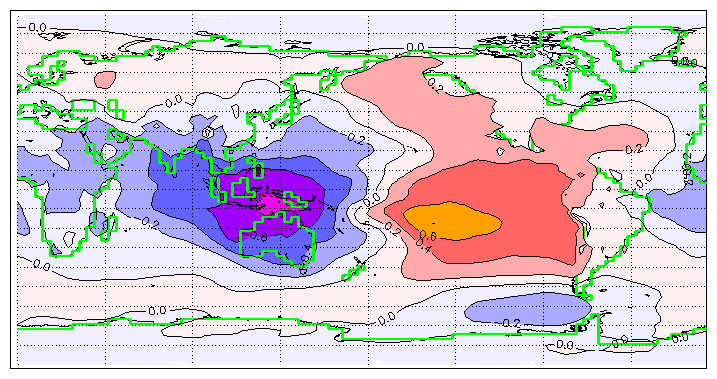
The so-called El Nino weather trend is anticipated to have an impact on the approaching monsoon season in South Asia including Nepal. The World Weather Organisation (WMO) has warned that there is a 60 per cent possibility that El Nino will cause dryness and increase heat in many parts of the world over the next three months. The WMO has placed India along with Nepal as the regions affected by impending drought.
El Nino is a weather condition in which the surface water temperature of the eastern Pacific Ocean is unusually warm and the air above the surface is also warm, disrupting the regular weather system.
The impact of below-normal rainfall in the dry monsoon and high temperatures on agriculture and livelihoods can be tremendous, according to Anil Pokharel. It can also increase the risk of communicable diseases, such as dengue, which saw over 50,000 cases recorded last year in Nepal. “We need to prepare for possible public health risks,” Pokharel says, “We must be prepared for both the regular disasters and the worst-case situation for public health.”
Officials of the Epidemiology and Disease Control Division (EDCD) say the agency is gearing up to tackle a potential dengue outbreak. According to Dr Gokarna Dahal, the agency’s Vector-borne Disease Control Section Chief, the EDCD is collaborating with various public health sectors to control the spread of dengue, given the high number of reported cases last year. “To effectively manage a potential dengue outbreak, everyone must play a crucial role, and it is essential to exercise caution when it comes to mosquito bites,” he says.
This story first appeared on Nepal Check and Onlinekhabar is republishing it under the Creative Commons licence.










